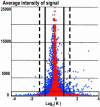STAT1 is overexpressed in tumors selected for radioresistance and confers protection from radiation in transduced sensitive cells
- PMID: 14755057
- PMCID: PMC341831
- DOI: 10.1073/pnas.0308102100
STAT1 is overexpressed in tumors selected for radioresistance and confers protection from radiation in transduced sensitive cells
Abstract
Nu61, a radiation-resistant human tumor xenograft, was selected from a parental radiosensitive tumor SCC-61 by eight serial cycles of passage in athymic nude mice and in vivo irradiation. Replicate DNA array experiments identified 52 genes differentially expressed in nu61 tumors compared with SCC-61 tumors. Of these, 19 genes were in the IFN-signaling pathway and moreover, 25 of the 52 genes were inducible by IFN in the nu61 cell line. Among the genes involved in IFN signaling, STAT1alpha and STAT1beta were the most highly overexpressed in nu61 compared to SCC-61. STAT1alpha and STAT1beta cDNAs were cloned and stably transfected into SCC-61 tumor cells. Clones of SCC-61 tumor cells transfected with vectors expressing STAT1alpha and STAT1beta demonstrated radioprotection after exposure to 3 Gy (P < 0.038). The results indicate that radioresistance acquired during radiotherapy treatment may account for some treatment failures and demonstrate an association of acquired tumor radioresistance with up-regulation of components of the IFN-related signaling pathway.
Figures




References
-
- Hall, E. J. (2000) Radiobiology for Radiologist (Lippincott Williams and Wilkins, Philadelphia), 5th Ed., pp 5-17.
-
- Harris, A. L. (2002) Nat. Rev. Cancer 2, 38-47. - PubMed
-
- Taylor, A. M. (1998) Int. J. Radiat. Biol. 73, 365-371. - PubMed
-
- Young, B. R. & Painter, R. B. (1989) Hum. Genet. 82, 113-117. - PubMed
-
- Valerie, K. & Povirk, L. F. (2003) Oncogene 22, 5792-5812. - PubMed
Publication types
MeSH terms
Substances
Grants and funding
LinkOut - more resources
Full Text Sources
Other Literature Sources
Molecular Biology Databases
Research Materials
Miscellaneous

